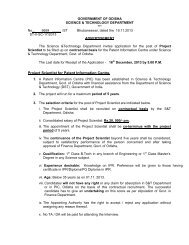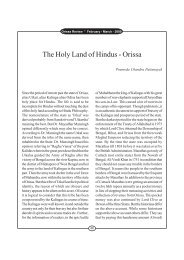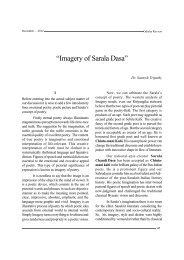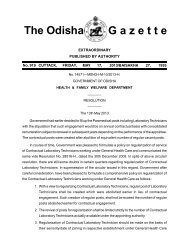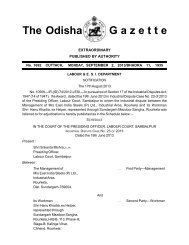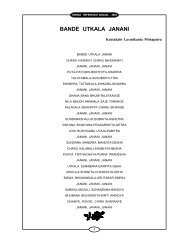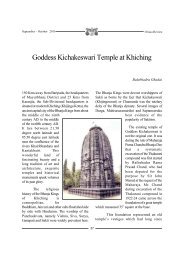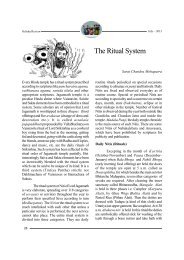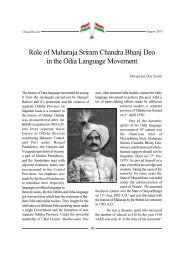Kalinga and Funan : A Study in Ancient Relations
Kalinga and Funan : A Study in Ancient Relations
Kalinga and Funan : A Study in Ancient Relations
Create successful ePaper yourself
Turn your PDF publications into a flip-book with our unique Google optimized e-Paper software.
Orissa Review<br />
different epochs <strong>and</strong> found expression of its<br />
particular form <strong>in</strong> Cambodian art <strong>and</strong><br />
architecture 8 .<br />
The orig<strong>in</strong> of the k<strong>in</strong>gdom of <strong>Funan</strong>,<br />
however, is shrouded <strong>in</strong> mystery. Accord<strong>in</strong>g to<br />
K’ang T’ai, a Ch<strong>in</strong>ese envoy who visited <strong>Funan</strong><br />
<strong>in</strong> the middle of the third century CE, the first k<strong>in</strong>g<br />
of <strong>Funan</strong> was a certa<strong>in</strong> Hun-t’ien, that is,<br />
Kaund<strong>in</strong>ya, who came either from India or from<br />
the Malay Pen<strong>in</strong>sula or the southern isl<strong>and</strong>s. 9 This<br />
Ch<strong>in</strong>ese version of the dynastic orig<strong>in</strong> of <strong>Funan</strong><br />
has been corroborated by a Sanskrit <strong>in</strong>scription<br />
of Champa belong<strong>in</strong>g to the third century CE.<br />
Though scholars agree on the po<strong>in</strong>t that the<br />
k<strong>in</strong>gdom of <strong>Funan</strong> came <strong>in</strong>to existence some time<br />
dur<strong>in</strong>g the first century CE, after union of a Brahm<strong>in</strong><br />
named Kaund<strong>in</strong>ya with the Naga Pr<strong>in</strong>cess<br />
Soma(Lieu-Ye), there is considerable<br />
disagreement on the homel<strong>and</strong> of Kaund<strong>in</strong>ya. This<br />
mystical union which was still commemorated at<br />
the court of Angkor at the end of the thirteenth<br />
century <strong>in</strong> a rite identical with that of the Pallava<br />
k<strong>in</strong>gs of Kanchi made some scholars to believe<br />
that Kaund<strong>in</strong>ya probably belonged to the Pallava<br />
k<strong>in</strong>gdom. 10 On the basis of the Mysore <strong>in</strong>scription<br />
(2 nd century CE) which records the grant of l<strong>and</strong>,<br />
to a Siva shr<strong>in</strong>e of the Brahm<strong>in</strong>s of the Kaund<strong>in</strong>ya<br />
gotra (clan), B.R. Chatterjee po<strong>in</strong>ted out that<br />
Kaund<strong>in</strong>yas might have migrated from Mysore<br />
to Indo-Ch<strong>in</strong>a. 11 H.B. Sarkar 12 , however, has<br />
rejected this view <strong>and</strong> proposed that the migrat<strong>in</strong>g<br />
clan of Kaud<strong>in</strong>yas might have migrated to <strong>Funan</strong><br />
from the Amaravati region of Andhra on the ground<br />
of the discovery of specimens of Amaravati style<br />
of sculpture at Dong Duong which was then under<br />
<strong>Funan</strong>. He argues that the Mysore Kaund<strong>in</strong>yas<br />
were not <strong>in</strong> the picture <strong>in</strong> the first century CE when<br />
<strong>Funan</strong> was founded; hence the Kaund<strong>in</strong>yas of<br />
<strong>Funan</strong> could not have gone from the Mysore<br />
region. On the other h<strong>and</strong>, though many scholars<br />
34<br />
November - 2011<br />
have admitted the important role of <strong>Kal<strong>in</strong>ga</strong> <strong>in</strong><br />
the Indianization of Southeast Asia dur<strong>in</strong>g the early<br />
centuries CE, none of them so far has taken notice<br />
of Kaund<strong>in</strong>ya Brahm<strong>in</strong>s who still cont<strong>in</strong>ue to live<br />
near Mahendra mounta<strong>in</strong> range of Orissa which<br />
is very close to the sea. On the basis of this, it is<br />
presumed that the Kaund<strong>in</strong>ya Brahm<strong>in</strong>s might<br />
have migrated from Mahendra mounta<strong>in</strong> region<br />
of <strong>Kal<strong>in</strong>ga</strong> <strong>and</strong> the port of Palur which was<br />
referred to by Ptolemy, the Greek geographer<br />
dur<strong>in</strong>g the 2 nd century CE as an <strong>in</strong>ternational port<br />
could be the port from where Kaund<strong>in</strong>ya<br />
embarked for <strong>Funan</strong>.<br />
The ma<strong>in</strong> reason for the belief that the<br />
homel<strong>and</strong> of Kaund<strong>in</strong>ya Brahm<strong>in</strong>s of <strong>Funan</strong> could<br />
be Mahendra Parvata of <strong>Kal<strong>in</strong>ga</strong> arises from the<br />
fact that the name of Mahendra Mounta<strong>in</strong> appears<br />
<strong>in</strong> the history of <strong>Funan</strong> on two important<br />
occasions. The History of the Southern Ch’i<br />
states that dur<strong>in</strong>g the reign of Jayavarman (5 th<br />
century CE) ‘the custom of this country [<strong>Funan</strong>]<br />
was to worship the God Mahesvara (Siva)’who<br />
cont<strong>in</strong>ually descends on Mount Mo-tan. 13 Motan<br />
could be another name of Mahendragiri of<br />
Orissa which was also considered as an abode<br />
of Lord Siva <strong>and</strong> early Saivism. 14 It was shortly<br />
before c. 500 CE that the Gangas of <strong>Kal<strong>in</strong>ga</strong>(the<br />
Eastern Gangas) were worshipp<strong>in</strong>g Siva-<br />
Gokarnasvam<strong>in</strong> as the tutelary deity of the family<br />
(ista-devata) on Mahendra Mounta<strong>in</strong> 15 . Even<br />
now there is the shr<strong>in</strong>e of Gokarnesvara on the<br />
top of the hill. Worshipp<strong>in</strong>g of Gokarnasvam<strong>in</strong><br />
(on Mahendra Parvat <strong>in</strong> <strong>Kal<strong>in</strong>ga</strong>) <strong>and</strong><br />
Mahesvara (<strong>in</strong> <strong>Funan</strong>) belonged to the same time.<br />
This led to an important assumption that as <strong>Funan</strong><br />
was Indianised by the traders <strong>and</strong> merchants from<br />
the eastern coast of India, the migrants, with the<br />
passage of time named a local mounta<strong>in</strong> of <strong>Funan</strong><br />
as Mahendraparvata after the Mahendra<br />
Parvata of Orissa which had god<br />
Mahesvara(Gokarnesvara) on it. The imitation <strong>and</strong>



